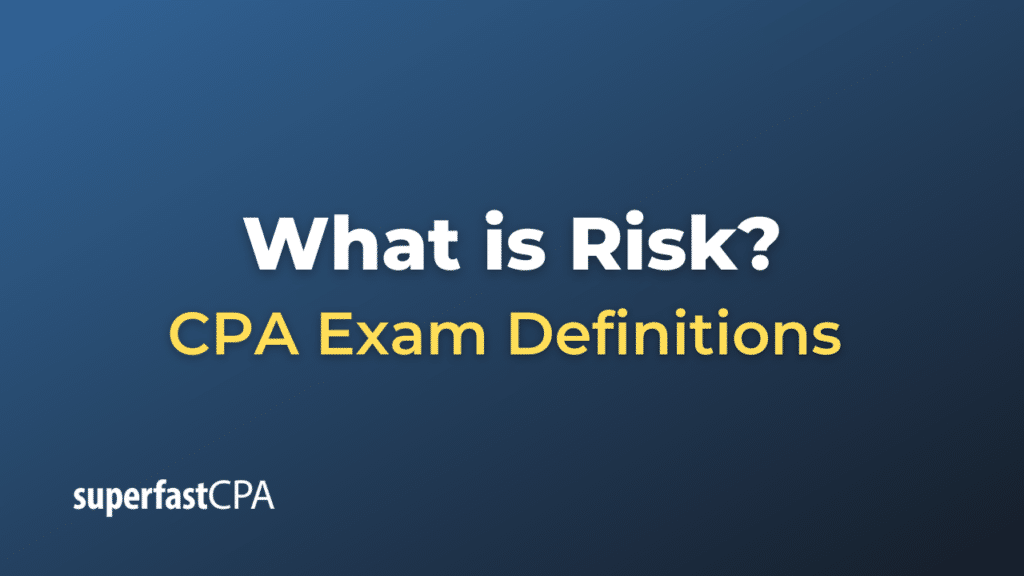Risk
Risk, in its broadest sense, refers to the uncertainty surrounding future outcomes. It represents the potential of gaining or losing something of value when pursuing a particular action or decision. Risk can be related to finance, health, investments, safety, and many other areas of life and business. Here are some key perspectives on risk:
- Financial Risk: This refers to the potential for financial loss. It can come from various sources, such as market movements, credit defaults, or liquidity crises. Investors, businesses, and individuals face financial risks when they make investment decisions.
- Operational Risk: Businesses often encounter risks related to their operations. This can include anything from a machine breakdown to a full-blown operational failure due to various factors.
- Strategic Risk: This type of risk arises from managerial decisions that might affect the long-term goals of a company. Wrong strategic decisions can cause significant harm to an organization’s growth and sustainability.
- Reputational Risk: Companies also face risks related to their public image. A PR disaster or a negative event associated with a company’s product or behavior can have long-lasting implications on its brand and value.
- Health Risks: These relate to the potential for physical or mental health consequences due to certain behaviors, exposures, or genetic factors. Smoking, for instance, carries health risks such as heart disease and lung cancer.
- Safety Risks: In everyday life, individuals face potential harm from various activities. Driving a car, for instance, comes with the risk of accidents.
- Political and Legal Risks: Businesses, especially those operating internationally, can face risks related to political instability or changes in laws and regulations.
- Market Risk: Also known as “systematic risk,” this pertains to the potential for an investor to experience losses due to factors that affect the overall performance of the financial markets.
- Liquidity Risk: Refers to the potential that an individual or firm may not be able to exit an investment as quickly as they wish due to a lack of buyers in the market.
- Interest Rate Risk: This is the potential for investment losses due to a change in interest rates. For instance, bond prices typically fall when interest rates rise.
- Credit Risk: This is the potential for a borrower to default on a loan or for a counterparty to default on a financial obligation.
In decision-making, risks are often evaluated against potential rewards. In many contexts, a higher potential reward is accompanied by a higher level of risk. Proper risk management involves identifying, assessing, and prioritizing risks to minimize potential negative impacts.
Example of Risk
Imagine you have $10,000 to invest and you’re considering two main options: investing in a promising tech startup’s stock or buying government bonds.
- Tech Startup Stock:
- Potential Reward: The startup has a new product that could revolutionize its industry. If the product becomes a hit, the company’s stock could potentially double or even triple in a few years.
- Risk: The tech industry is volatile. There’s a chance the product might not be as successful as anticipated, competitors might release a better product, or unforeseen operational challenges could arise. As a result, you could potentially lose a significant portion or even all of your initial investment if the company fails.
- Government Bonds:
- Potential Reward: Government bonds are seen as safer investments. The bond promises a 3% annual return. So, after a year, you’d earn $300 in interest.
- Risk: Bonds, especially those issued by stable governments, are considered low-risk investments. The primary risk is the opportunity cost – the potential returns you’re missing out on by not investing in a higher-risk, higher-reward option. Additionally, there’s the “interest rate risk.” If market interest rates rise above 3%, the value of your bond might decrease if you decide to sell it before maturity.
Decision Time:
You decide to diversify to balance the potential rewards against the risks. You invest $7,000 in government bonds to ensure a safer return and put $3,000 in the tech startup stock, hoping for a higher return.
Outcome:
A year later, a few scenarios could play out:
- The tech startup’s product is a massive success, and its stock price doubles. Your $3,000 investment is now worth $6,000.
- The tech startup’s product fails to take off, and its stock price drops by 50%. Your $3,000 is now worth $1,500.
- The bond market remains stable, and you earn a 3% return on your $7,000 investment in government bonds, which equals $210.
Depending on the outcome for the tech startup, your total portfolio value could vary, demonstrating the risks and rewards inherent in investment decisions.













